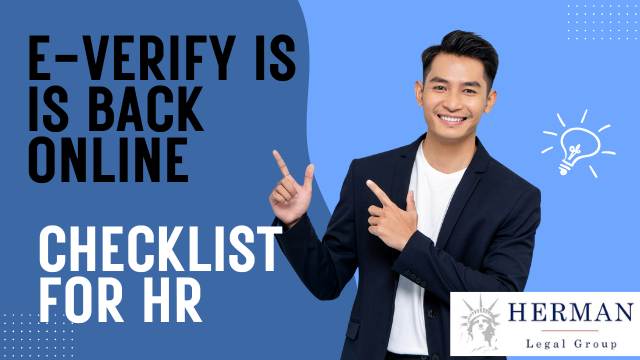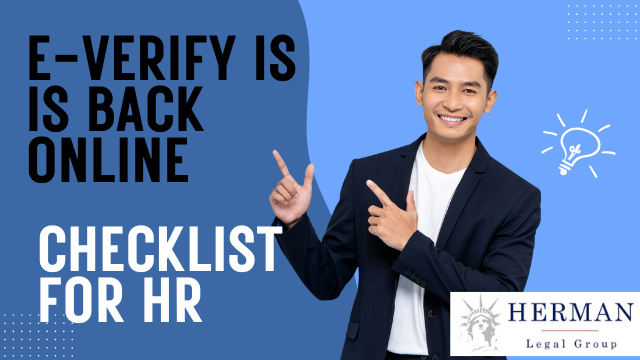The temporary shutdown of the federal government has once again exposed the fragility of employment eligibility verification processes. The lapse in federal government funding led to the system’s temporary unavailability, directly impacting the operational status of the E-Verify system. For HR and compliance professionals, the sudden restoration of the E-Verify system by U.S. Citizenship and Immigration Services (USCIS), under the Department of Homeland Security (DHS), signals a crucial, short window of opportunity to correct non-compliance issues without penalty. The E-Verify system was impacted by the federal government shutdown, and its restoration was prioritized due to its essential role in employment verification.
The system, which had been shut down since October 1 due to a government funding lapse, was restored on October 7, 2025. Restoring access and operational status was necessary to support ongoing worksite enforcement and compliance teams. The E-Verify system is considered an essential tool that aligns with broader policy priorities, such as employment eligibility verification, compliance, and worksite enforcement, even during ongoing federal government shutdowns. The system may be back up, but the clock is ticking on strict deadlines for new hires and unresolved mismatch cases.
This comprehensive guide, informed by the latest USCIS guidance, is your roadmap to navigate the post-outage compliance recovery phase. With an ongoing emphasis on compliance and the need for the system to remain operational to support employers, HR, and compliance teams, it covers the critical deadlines, the mandatory steps for case creation and Tentative Nonconfirmation (TNC) re-referral, and specific guidance for federal contractors and E-Verify+ users.
U.S. Citizenship and Immigration Services (USCIS) officially confirmed the resumption of the E-Verify system on October 9, 2025.

Key Compliance Deadline: The October 14th Mandate
The most urgent task for every E-Verify participant is managing the grace period for new hire cases that could not be created during the shutdown (October 1–8, 2025). Employers should begin submitting cases as soon as possible to ensure compliance within the allowed timeframe.
Employers must create E-Verify cases for all affected new hires and take prompt action to correct course before the deadline.
What is the Deadline to Submit Delayed E-Verify Cases?
Employers must create an E-Verify case by Tuesday, October 14, 2025, for every employee hired while the E-Verify system was unavailable. System employers must ensure all cases are submitted by the deadline to remain compliant with verification requirements.
The mandatory three-business-day rule for E-Verify case creation was paused during the system’s downtime. However, that grace period ends with the October 14 deadline, a date that should be treated as absolute.
Mandatory Steps for Delayed Case Creation
For all employees hired during the outage, follow these precise steps when submitting their cases into the now-active E-Verify system:
- Enter the Hire Date Listed: You must enter the hire date listed on the employee’s completed Form I-9, Employment Eligibility Verification, exactly as it appears on the form.
- Acknowledge the Delay: Since the case is being submitted outside the normal three-day window, the system will prompt you for a reason for the delay.
- Select the Official Reason:
- Choose “Other” from the “Select a Reason for Delay” dropdown menu.
- Enter the Specific Explanation:
- In the accompanying text box, type the official reason: “E-Verify’s unavailability.”
Users must log in via Login.gov and use multi-factor authentication to access their E-Verify accounts.
This procedure ensures that the system records the delay correctly and that the time the system was offline does not count against your standard compliance obligations. Employers are advised to submit any backlogged cases and close out any that are ready after the system’s restoration.
Following these steps will help demonstrate compliance with E-Verify requirements during periods of system disruption.
TNC Resolution: How to Re-Refer Mismatch Cases
A Tentative Nonconfirmation (TNC), or mismatch, occurs when an employee’s Form I-9 data doesn’t align with records from the Social Security Administration (SSA) or DHS (these are also known as tentative nonconfirmations). Since employees were unable to contest TNCs while the system was down, employers must now issue updated deadlines, and employers must respond promptly to resolve tentative nonconfirmations now that the system is back online.
What is a TNC Re-Referral?
A TNC Re-Referral is the process of updating and reissuing a new Referral Date Confirmation to an employee who had a pending mismatch case during the E-Verify outage, granting them extended time to contact the SSA or DHS to resolve the issue. The updated referral deadline is calculated based on the original referral date, ensuring compliance with E-Verify requirements. If the employer previously issued a notice to the employee, they must now provide an updated employee’s notice with the correct referral date confirmation based on the current case details.
If an employee received a TNC and had already decided to contest it before or during the shutdown, you must immediately revise the deadline by which they must contact SSA or DHS. You have three approved options for managing this critical update:
3 Approved Methods to Update the Referral Date Confirmation
| Priority | Method | Action Required |
|---|---|---|
| Best Practice | Generate New Notice | Print a new Referral Date Confirmation notice directly from the E-Verify system (Preferred method). This new notice will automatically display the correct, extended deadline for the employee. |
| Alternate Option | Manual Write-In | Log into E-Verify, find the case, note the updated referral date displayed in the system, and manually write the new date on the previously issued notice. |
| Fallback Method | Manual Calculation | Add six federal business days to the original date printed on the employee’s Referral Date Confirmation notice. (Federal business days are Monday through Friday, excluding federal holidays.) |
Note: For cases referred after E-Verify resumed operations, standard resolution deadlines apply. Be sure to follow standard resolution deadlines when re-referring cases or updating referral notices.
Important Note on Cases Referred After System Resumption:
If an employee’s mismatch case was referred after E-Verify resumed operations (e.g., on or after October 8, 2025), no additional days are added to the deadline; the standard resolution timeline applies, as the system has already accounted for any necessary timing adjustments. If an employee was unable to contest a mismatch due to the system’s unavailability, you should now refer their case and follow the TNC process.
Remote I-9 and E-Verify+ Guidance
The shutdown also impacted employers using the more advanced digital tools for compliance. However, a remote inspection workflow is available for qualified employers, allowing them to continue remote I-9 inspections through DHS’s alternative procedure.
Employers who were using virtual review prior to the shutdown can continue this process during the catch-up period, and the alternative procedure remains valid for qualified employers. This ensures continuity and compliance for those utilizing remote I-9 verification methods.
E-Verify+ and Employee Action Deadlines
For employers enrolled in E-Verify+, the platform will now display corrected instructions and deadlines for employees with pending TNCs.
- Employee Action: Employees who were prevented from contesting a mismatch must log back into their myE-Verify account and check the “What’s Next” page for their new, official deadline to contact the Social Security Administration or the Department of Homeland Security.
Remote I-9 Document Inspection
The DHS-authorized alternative procedure for remote Form I-9 document inspection remains fully valid for qualified E-Verify employers.
- Continuing Remote Review: If your organization was already enrolled and actively using the virtual document review procedure prior to the system’s unavailability, you may continue to use this method during this compliance catch-up period. This allows for efficient remote onboarding during the recovery phase.
Federal Contractor Compliance: Navigating FAR Requirements
Federal contractors are subject to the E-Verify Federal Contractor Rule (via the Federal Acquisition Regulation, or FAR) and face unique, stringent deadlines. Extensions for employers subject to federal contractor rules must be coordinated with contracting officers directly to ensure compliance with updated requirements.
If there are delays or disruptions, such as E-Verify unavailability, employers should coordinate extensions and confirm new deadlines with contracting officers directly.
Do Federal Contractor E-Verify Deadlines Still Apply?
No. Any calendar day when E-Verify was unavailable will not count toward federal contractor compliance deadlines. However, contractors are not relieved of their obligations; they must coordinate extensions directly with their contracting officers.
Action Plan for Federal Contractors
- Coordinate with Your Contracting Officer: The primary action for federal contractors is to immediately contact their contracting officer to confirm any new timeframes, expectations, and necessary documentation for contract-specific deadlines. During the recovery phase, employers must be proactive in coordinating with contracting officers and documenting all compliance actions to ensure a smooth transition back to normal operations.
- Compliance Pause, Not Erasure: While the unavailability of E-Verify paused certain countdown clocks, the underlying compliance obligation remains. The delay simply shifts the required compliance schedule.
- Enrollment and Existing Cases: If your organization was a new federal contractor and could not enroll, or if you had existing cases that needed to be created or resolved for employees working on a federal contract, treat them with the same urgency as all other delayed E-Verify cases and document all communication with the contracting officer.
Best Practices: Documentation, Diligence, and Contingency Planning
The core lesson from any E-Verify outage is the critical need for a robust, redundant compliance process that goes beyond the electronic system. Employers should retain records and save supporting documents for all delayed submissions and reissued notices to demonstrate compliance with I-9 regulations and E-Verify procedures, especially during and after disruptions.
Pre-Outage vs. Post-Outage Compliance
Employers who managed to maintain full Form I-9 compliance during the E-Verify hiatus—completing Section 2 and retaining copies of supporting documents—will have a far easier time reconciling their cases now.
- I-9 is Mandatory: Remember: Form I-9 completion is never waived. It must still be completed within three business days of an employee’s start date, even if E-Verify is offline. Failure to do so exposes the employer to civil penalties.
- Prohibited Actions: You must refrain from taking any adverse action against an employee, such as suspension or termination, due to a pending or unresolved TNC while the system was unavailable. This is a critical anti-discrimination safeguard enforced by the Department of Justice’s Immigrant and Employee Rights Section (IER).
Preparing for Delays and Audits
USCIS has warned that a surge in activity will likely lead to higher-than-normal call volumes and slower response times from E-Verify Customer Support. The recent outage has reminded employers of the importance of robust compliance processes and understanding the full scope of E-Verify operations, including related functions that can be performed after restoration. Employers can now perform related functions such as closing cases and addressing Tentative Nonconfirmations (TNCs) as part of resumed E-Verify operations.
| Compliance Imperative | Action to Take Now | Rationale |
|---|---|---|
| Prioritize Speed | Start submitting delayed cases immediately; do not wait until the October 14 deadline. | Reduces backlog risk and demonstrates maximum good-faith effort. |
| Comprehensive Documentation | Track and save records of all delayed case submissions, the date of submission, the reason for the delay (“E-Verify not available”), and all reissued TNC notices. | Essential defense for demonstrating good-faith compliance in the event of a future audit. Reminded employers not to assume silence means compliance and to proactively follow up on all cases. |
| Vigilant Follow-Up | Regularly check the status of all open mismatch cases and proactively communicate the updated TNC deadlines to employees. | Minimizes employee confusion and ensures timely TNC resolution. |
(
The reliability of E-Verify is tied to government funding, making it susceptible to political instability. A mature, compliant HR department treats the system as a supplement to, not a replacement for, the core Form I-9 process. By acting swiftly and documenting every step of the recovery process, employers can successfully navigate this post-outage environment and safeguard their employment practices. However, the possibility of additional E-Verify outages remains, as its legal authority had not been reauthorized by Congress at the time it resumed operations.
Author Bio/Profile: Richard T. Herman, Esq.
Richard T. Herman, Esq., is a nationally recognized immigration attorney, author, and public advocate who has dedicated his career to advancing immigrant rights and advocating for the economic revitalization of American cities through smart immigration policy.
- Founder and President: Mr. Herman is the founder and president of the Herman Legal Group, a nationwide immigration and business law firm headquartered in Cleveland, Ohio, serving a global clientele.
- Author of Immigrant, Inc.: Richard is the co-author of the acclaimed book, Immigrant, Inc.: Why Immigrant Entrepreneurs Are Driving the New Economy (and How They Will Save the American Worker). The book presents a powerful, research-backed argument on the essential role of immigrants as drivers of innovation and job creation in the U.S. economy.
- Advocacy & Expertise: He is a thought leader on employment-based immigration, complex Form I-9 compliance issues, and the use of immigration as an economic development tool, having co-founded non-profit initiatives like Global Cleveland and Global Detroit.
For more details on Richard T. Herman’s professional background, accomplishments, and commitment to immigration advocacy, you can read his full profile on his Richard Herman Bio Page.








